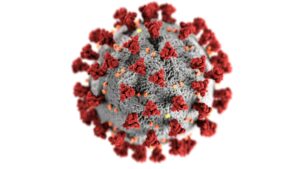These days a video going viral of China’s hospital where a huge crowd of people can be seen who are affected by a new virus called as “HMPV(Human Metapneumovirus)”. China is facing a concerning rise in respiratory illness because of HMPV but there is no official announcement about this by the China’s government. Instead of this the health authorities have implemented some protocols to know more about this pathogen virus since December 2024. Many people predicting that this virus is similar to Corona because it also affects the respiratory system of humans. Is it similar or not?

Introduction
The Human Metapneumovirus (HMPV) is a respiratory virus that primarily infects the lungs. It was discovered in 2001 and belongs the same family of the respiratory syncytial virus (RSV) and the measles virus called as “Paramyxoviridae family”. It is highly infectious virus that spreads through respiratory droplets, close contact, or contaminated surfaces which makes it common to spread in crowded place.
HMPV affects people of all ages but it is especially significant in young children, the elderly and the person with weakened immune system. In children, it is the cause of respiratory illness and cause symptoms similar to flu, RSV or the common cold.
HMPV infections are generally mild but they can lead to severe respiratory conditions, such as bronchiolitis, pneumonia, or exacerbation of asthma.
Signs and Symptoms of HMPV
When a child is infected by Human Metapneumovirus (HMPV) often exhibit mild symptoms that can be similar to those of a common cold. These symptoms can be seen within a few days of exposure to the virus. Here’s a closer look at each of the mild symptoms and what they mean:
Runny Nose (Rhinorrhea)
A runny nose is one of the most common signs of an HMPV infection. The virus cause irritation to the lining of the nasal passages and causing them to produce excess mucus. This symptoms is often known by nasal congestion, which can make difficult to breath for younger child, especially infants.
How to manage it:
- Encourage gentle blowing of the nose for older children.
- Use a saline nasal spray or suction bulb for infants to help clear the nasal passages.
Cough
A persistent cough may develops because the virus irritates the throat and respiratory tract. Initially, the cough is usually dry at first but may become slack (with mucus) when infection progresses.
How to manage it:
- Keep the child hydrated to help in calmness the throat and thin mucus.
- A humidifier can help moisten the air and reduce coughing fits.
- Avoid giving excess cough medicines to young children unless recommended by a doctor.

Sore Threat
A sore throat may cause swelling because the virus infects the upper respiratory tract. This can make uncomfortable to swallow and may have pain or scratchy feeling in the throat.
How to manage it:
- Offer warm liquids like soup or herbal tea for older children to soothe the throat.
- Cold foods like popsicles or yogurt can also provide relief.
- Ensure the child is eating soft, easy-to-swallow foods.
Low-Grade Fever
A person may also feel mild fever as the body works to fight from the infection. The fever typically ranges between 100°F and 101°F (37.8°C to 38.3°C) and may be accompanied by fatigue or a general feeling of discomfort.
How to manage it:
- Use age-appropriate fever-reducing medications like acetaminophen (Tylenol) or ibuprofen (Advil) if the fever causes discomfort. Always follow dosage instructions.
- Keep the child comfortable and dressed in lightweight clothing.
- Ensure they rest and stay hydrated.
How HMPV is spread
HMPV is commonly spread through respiratory droplets that comes out when an infected person coughs, sneezes, or talks. These small droplets contain the virus which can travel short distances, typically less than 6 feet. When an infected person sneezes or coughs, droplets containing the virus are released into the air. If another person inhales these droplets, the virus can enter into his respiratory tract and cause infection. This mode of transmission is especially common in crowded or poorly ventilated spaces.
This virus can survive on surfaces for several hours. When a healthy person touches the surface and then touch his mouth, eyes or nose this virus can enter in his body. Children are particularly infected by this virus because they often touch their face and share toys and objects.
When someone comes in contacts with the infected person this virus also transmitted into their body. This includes hugging, kissing, or sharing utensils with an infected person.
Prevention Tips

- Encourage infected individuals to cover their mouths and noses with a tissue or their elbow when sneezing or coughing.
- Maintain physical distance from people showing symptoms of respiratory illness.
- Disinfect frequently-touched surfaces regularly, especially during outbreaks.
- Encourage frequent handwashing with soap and water for at least 20 seconds, particularly before meals and after touching shared objects.
- Use hand sanitizers with at least 60% alcohol when handwashing isn’t feasible.

- Avoid close contact with individuals who show signs of illness, such as coughing or sneezing.
- Teach children not to share utensils, cups, or personal items with others.
Is it the same as corona ?
The Human Metapneumovirus (HMPV) and the Coronavirus (specifically SARS-CoV-2, which causes COVID-19) have some similarities as both are respiratory viruses, but they also have distinct differences.
Similarities :
The mode of transmission is same for both the viruses. As they spread primarily through respiratory droplets when a person sneezes, coughs or talks. They can also spread when a person comes in contact with the infected one.
Both the viruses cause similar symptoms like runny nose, cough, sore throat, fever or Shortness of breath (in severe cases). They can range from mild to severe and sometimes lead to complications like pneumonia or bronchiolitis.
Both the viruses pose higher risk to infants, young children and the elderly one. It also affects the person with weak immune system.
There is currently no vaccine for Human Metapneumovirus (HMPV), unlike SARS-CoV-2 (COVID-19), which has multiple vaccines available. This difference exists because:
- Global Impact: SARS-CoV-2 caused a global pandemic with high death tolls and severe economic impact, while HMPV causes seasonal, localized outbreaks.
- Urgency: The pandemic-level spread of COVID-19 created an urgent need for vaccines, whereas HMPV is less severe for most people.
- Funding & Focus: Massive resources were directed toward COVID-19 vaccine development, while HMPV has been a lower priority.
- Scientific Challenges: HMPV vaccine development is complicated due to its ability to evade long-lasting immunity.

Despite these challenges, ongoing research may eventually lead to an HMPV vaccine, particularly for vulnerable populations like children and the elderly.
While HMPV doesn’t currently have a vaccine, its burden on healthcare systems (especially pediatric and elderly care) ensures it remains an area of active research. Breakthroughs in vaccine technology, such as mRNA platforms, could pave the way for effective HMPV vaccines in the future, especially for vulnerable populations.
In the meantime, prevention relies on hygiene practices, early detection, and supportive care.
